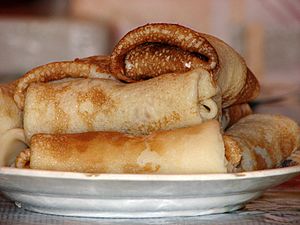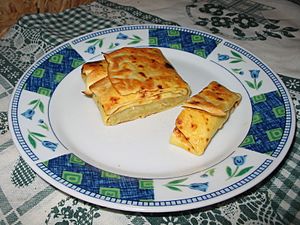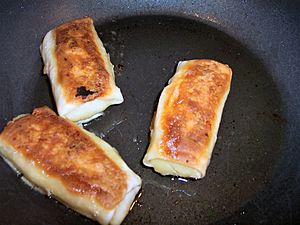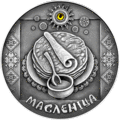Blini facts for kids

Blini
|
|
| Alternative names | Blin, bliny, blintchik, blynchyky |
|---|---|
| Type | Pancake |
| Place of origin | Russia |
| Main ingredients | Wheat, eggs, milk |
A blini is a type of thin pancake that comes from Russia and other Eastern European countries. People usually make blini from wheat or buckwheat flour. They are often served with toppings like sour cream (called smetana), butter, or even caviar. Blini are one of the most loved and eaten foods in Russia.
In some places, especially outside of Russia, "blini" might mean small, savory pancakes. But in Russia today, the word usually means a large, thin pancake, like a crêpe. Sometimes, smaller pancakes are also called blini.
You might hear "blin" for one pancake and "blini" for many. However, in English, people often use "blini" for both one pancake and many.
Contents
What are Blini?
Blini are a kind of pancake, but they are usually very thin. They are made from a special batter that often includes yeast. This makes them light and airy. Blini can be eaten for breakfast, lunch, or dinner. They are a versatile food that can be sweet or savory.
The History of Blini

Long ago, in Eastern Europe, blini were seen as a symbol of the sun. This was because of their round shape. People traditionally made them at the end of winter. This celebrated the sun's return and the start of spring.
This tradition is part of a festival called Maslenitsa, or "Pancake Week." It's a time to enjoy dairy foods before a period of fasting. Many cultures have similar pancake celebrations, like Shrove Tuesday in Western countries. Blini were also sometimes served at special gatherings to remember people who had passed away.
How Blini are Made
Traditional Russian blini are made with a special batter that uses yeast. The yeast helps the batter rise, making the pancakes fluffy. After rising, the batter is thinned with milk, sour milk, or water. Sometimes boiling water is used, and these are called zavarniye bliny.
There are also lighter, thinner blini made without yeast. These use flour, eggs, and milk or sour milk. Historically, blini were baked in a special Russian oven. Even today, people still say they "bake" blini, even though they are usually pan-fried. You can use different types of flour, like wheat, buckwheat, or oatmeal. Wheat flour is the most common today.
Blintzes: A Jewish Version
A dish similar to blini is called a blintz. This is a popular traditional Jewish food. Blintzes became well-known in the United States because of Jewish immigrants from Eastern Europe. They are an important part of Jewish cooking in some areas.
Blintzes are often served during Jewish holidays, like Shavuot. They are commonly filled with cheese and then fried. This is especially popular during Hanukkah, as oil is important to the Hanukkah story. Blintzes can also be filled with other things like chocolate, mushrooms, or meat. Unlike some blini, blintzes are usually stuffed and then fried again, or simply folded and eaten with a dip.
Blini in Ukraine
In Ukraine, blini are called mlyntsi. They are very popular because they are simple to make. They use basic ingredients but taste great. Ukrainians have eaten mlyntsi since ancient times.
Mlyntsi are often served with sour cream. They can also be a sweet dish with fruit preserves or sweet cream. You can stuff these thin pancakes with cottage cheese, eggs, onions, or meat. When stuffed, they get a new name: nalysnyky. Nalysnyky are a key part of Ukrainian cuisine. Different regions have their own special fillings. For example, in Chernihiv, they might use mushrooms and cabbage. The most popular nalysnyky are filled with cottage cheese and served with sour cream.
Like blini, nalysnyky are also eaten during Masnytsya (the Ukrainian Maslenitsa). This festival celebrates the end of winter. Nalysnyky can be folded into tubes, envelopes, or triangles. Sometimes, stuffed mlyntsi are even baked in an oven.
Different Ways to Enjoy Blini
Blini can be prepared and served in many delicious ways:
- Some blini have things mixed into the batter, like grated potato or apple and raisins. These are often thicker than the spongy pancakes you might find in North America.
- You can top blini with butter, sour cream, jam, honey, or caviar. Caviar can be from salmon or sturgeon.
- Blini can be folded or rolled around sweet or savory fillings. Popular fillings include fruit, mashed potatoes, quark (a type of cheese), cooked ground meat, chicken, or chopped eggs with green onions.
- "Blini s pripyokom" are made by pouring batter over chopped vegetables, meat, or mushrooms that are already in the frying pan.
- Blintzes are often filled with things like fruit, potato, or cheese. After being filled, they are lightly re-fried or baked. These are also known as nalysnyky in Ukraine. Caviar is a common filling for blintzes at Russian parties.
- Buckwheat blini are a traditional Russian food. They are also popular in Ukraine, where they are called hrechanyky. In Lithuania, they are known as grikių blynai.
Blini are also a traditional meal in Lithuania on Shrove Tuesday.
Images for kids
-
An old woman prepares blini in a Russian oven for the religious and folk holiday Maslenitsa. Postcard of pre-revolutionary Russia (before 1917) by B. V. Zvorykin.
-
Blini served with red caviar
See also
 In Spanish: Blini para niños
In Spanish: Blini para niños










